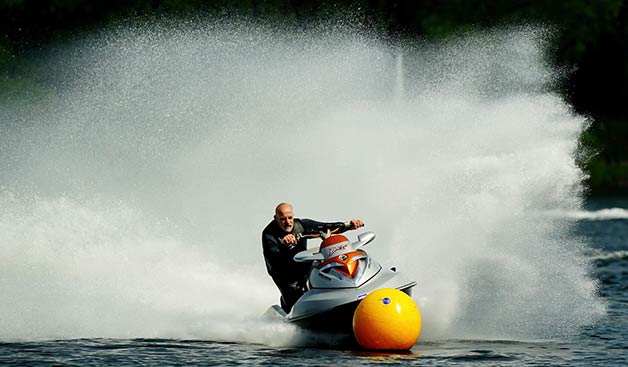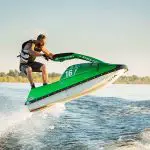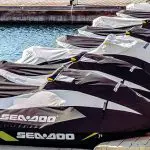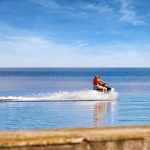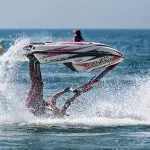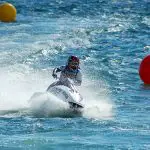The Sea-Doo Spark has been a lukewarm hit since its introduction, finding a bit of favor with some due to the low price of entry but being ignored by those who’ve only been sold on hugely powered deep-V hull behemoths by the industry.
This touches a nerve.
The Sea-Doo Spark is a right fun craft to ride in its own right, and offers enormous potential to an owner – however rare – who values a lightweight nimble, and downright fun to ride handling personal watercraft.
Contents
The Way We Were
Back in the late 50’s… well, the 1990’s… personal watercraft in the runabout model were largely two-seaters that weighed about 400 pounds and three-seaters that might weigh a hundred pounds more or so.
The two-seaters – Sea-Doo’s SP line, topped by the kingpin XP; Yamaha’s GP series; and Kawasaki’s ZXi – shared similar designs. For the most part, two-cylinder two-stroke engines were mounted in 22.5-degree semi-V hulls that were designed to come onto the plane quickly and dance across the top of the water in a thoroughly entertaining fashion.
Though hardly as demanding as the then still popular stand-up skis of the day, those lighter and more nimble sitdowns nonetheless required a modicum of skill to ride well – and they would damn well throw you off if you showed more abandon than respect, even if 85 horsepower or so represented a big output.
The three-seaters weighed a bit more, and most were delivered with deep-V hulls that were the precursor to today’s cruise ships, yet they were still far lighter and in many ways more playful than later four-stroke designs.
The Way It Was
By the mid-2000s, of course, personal watercraft had nearly doubled in size for the most part. Longer, wider, and far more hefty four-strokes had taken the lead on dealership show floors and in the sales department.
That was somewhat inevitable, as there was little else available.
Sea-Doo had recently introduced its since departed 3-D model, a chameleon of sorts that could be ridden as either a large stand-up or a diminutive sport-class craft with the help of a few levers and latches. They were pretty neat, actually, and while at the helm of Watercraft World magazine I wrote a column that I’ll excerpt here.
At Long Last, a Brand New Sub-500 Pound Personal Watercraft
Sea-Doo’s introduction of the Spark a few years back was perhaps primarily intended as a way to attract new customers at a lower price point, but it soon proved popular with a great many riders who wanted a personal watercraft that was light, nimble, and quick – if not fast, at least quick in its 90-horsepower incarnation.
Of course, performance oriented riders soon began to clamor for more performance.
Sea-Doo turned, as most do, to Riva Racing for collaboration on several traditional solutions such as an upgraded intake grate.
There are also a few new-school hop-ups available to Spark owners, but first, let’s have a look at tried and true performance upgrades.
Riva Racing Top Loader Intake
Riva’s replacement intake grate is designed to rid the Spark of prop spin and cavitation while also improving handling and stability.
Its wing design provides increased acceleration, improved handling, and greater straight-line stability, and the grate of course fits all Spark models.
Riva recommends the grate be paired with its pump seal kit (below) for best results.
Riva Racing Pump Seal Kit
Riva’s pump seal kit is designed exclusively for use with its top loader intake grate to further reduce cavitation and impeller spin. It is comprised of several molded inserts specifically designed to seal up open areas in the intake grate shoe.
Do note that this modification is not applicable to your Spark without changing to Riva’s intake grate.
Final Drive Upgrades
Two other age-old approaches to improving Sea-Doo performance are available from Riva – a variable pitch impeller, and a stainless steel wear ring.
Alone in the marketplace, Sea-Doo equips its personal watercraft with a hard plastic wear ring. This does have its advantages as an approach, as it means that when rocks or other debris travel through the intake, the replaceable wear ring generally takes the damage instead of the impeller itself.
However, the result is that as the wear ring literally wears – thus the name – or is damaged, the seal between the impeller blade and the ring gradually (or quickly when the debris is involved) deteriorates. This causes a loss of performance.
Riva Stainless Steel Wear Ring
Whether as a performance upgrade or as a replacement for a worn original equipment wear ring, Riva Racing’s 100 percent stainless steel wear ring will give your Spark both increased performance and durability. The Riva ring is precision machined for the tightest tolerance possible, thus improving acceleration.
Variable Pitch Impeller
The pitch of your impeller is the equivalent of final drive gearing in a car. Going old school, a Chevelle with a 4:10 rear pinion gear will accelerate faster than the same car equipped with a 3:23 gear, but the latter will have a higher top speed.
In PWC terms, an impeller with a pitch of 14 delivers quicker acceleration at the expense of top speed, while a 17-pitch impeller equipped ski would deliver a higher top speed, but take longer to achieve it.
While personal watercraft were once predominantly delivered with straight rate impellers, it’s now regular practice for manufacturers to deliver machines with a variable pitch prop.
Variable pitch impellers offer the best of both worlds by having a curved blade which acts as the lower gear under acceleration while still offering better top speeds.
Your Spark was delivered from the factory with a 12/17 variable pitch impeller. And that’s fine.
Alas, impellers are also worn items. Rocks, sticks, sand, debris, and even the turbulence of clean water will eventually wear away the prop surface. This leads to cavitation – sometimes obvious, sometimes not – that lessens performance.
Solas impellers are a long-time choice of PWC performance enthusiasts, and their stellar reputation for stainless steel replacement props is well deserved. Their larger blade area and hub design alone make them a performance upgrade as well as a suitable replacement part.
They are available factory direct, or from any number of suppliers. But since Riva offers them as well – in both 12/14 and 12/17 pitch configurations – we’ll continue to one-stop shop for the purposes of this article.
Opinions vary a bit, and you might want to research this yourself, but my experience tells me that the 12/17 is likely the best choice for most consumers with an unmodified or lightly modified PWC, while the 12/14 might work better with a more highly modified craft turning higher RPMs. (Either is recommended only for the 90-horse Spark, not the lower-powered version. But we’re about to get to that…)
You should probably consult your own Sea-Doo dealer for confirmation, but in my experience, none of these modifications will affect your factory warranty, by the way.
Now for a popular performance upgrade that probably would…
The New School: Reflashing Your Spark
The engine control unit (ECU) on your Spark is tunable with the proper interface and software – and there are myriad entities clamoring for your dollars to do just that.
With a reflash – adjustments made to the ignition and fuel mapping curve – either a 60-horsepower or a 90-pony Spark can be tuned to 110 horses while still running on pump gas.
However, if you do not live directly in the vicinity of a reputable and reliable company – more on that in a moment – you will likely have to remove your ECU (which isn’t difficult) and mail it off and wait for it to be returned. And yes, this will likely render your warranty null and void if that is a concern to you.
Reputable and reliability is the crux of the question for some.
PWC Muscle of Tampa, Florida, is a well-known and respected supplier of performance upgrade parts and accessories, and they offer the reflash service for $495.
Worx Racing Components, located in Lake Havasu City in the states with an Australian branch as well, is also a very reputable company that performance enthusiasts have used for many years, and their reflash service runs $550.
These are companies I feel comfortable recommending, but again, there are many more out there. Caveat emptor and all that.
A reflash results in resetting the rev limiter to a higher rpm level along with quicker and faster throttle response.
Go For Broke
The above are all cost-effective methods to improve the performance of your Spark – but there’s certainly more out there.
If you click on one of the links above and peruse any of those websites, you’ll find all kinds of candy and toys – Riva has complete Spark packages available that include all of the above and more… but now we’re talking about thousands of dollars and not hundreds.
As with any motorsport, how fast you want to go is closely tied to how much you want to spend.
